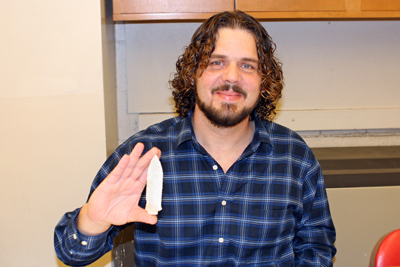
Jason Adair, a senior anthropology major at UMSL, researches stone remnants found in Chesterfield, Mo., through a College of Arts and Sciences Research Grant. He is one of seven grant recipients.
Jason Adair, a senior anthropology major at the University of Missouri–St. Louis, has an interest in studying stone tools and artifacts. So when his adviser Patti Wright suggested he look into a research project on stone remnants found in the Chesterfield, Mo., area, he took her up on it.
Adair, a resident of Maryland Heights, Mo., is one of seven undergraduates to receive this year’s College of Arts and Sciences Research Grants. The college created a Research Grant Program this year in order to promote undergraduate research. A faculty and student review committee selected seven undergraduates to receive funds to help them complete their research activities.
Adair’s project, “An Analysis of Etley vs. Stone Square-Stemmed Projectile Points,” will be overseen by Wright, associate professor of anthropology at UMSL.
“Jason is researching morphological and functional differences in nearly 4,000 year old assemblages of spear points from Missouri and Illinois. He began his investigation a year ago, presenting his preliminary results at a professional conference, “ she said. “With this award, Jason can continue his work, contribute to our knowledge of past Native American technology and subsistence practices, join the discussion about the usefulness of archaeological typologies, and, in the spring, present his findings at two additional conferences. Moreover, Jason has inspired other students to up their research and apply for future rounds of the grant.”
UMSL Daily caught up with Adair recently to talk about his research and the grant program for the first of seven Q&As featuring grant recipients.
How did you become interested in this research?
This research interests me because it involves stone tool analysis. I find the stone remnants of past cultures very intriguing. Also the artifacts I am analyzing were recovered locally from the Chesterfield area which may provide valuable information about culture in the St. Louis area approximately 4,000 years ago.
Why is this research important?
Stone tools are extremely important to understanding past human behaviors. Often they are the only surviving remnants, and for their prehistoric makers, they played a major role in facilitating critical tasks such as hunting and butchering meat. Archaeologists rely on the types and styles of stone artifacts to evaluate in what time periods and in what regions people lived, to understand dietary choices, to assess technological changes and to gain knowledge about patterns of trade and movement. To add to current archaeological discussions, I will analyze the two very important types of spear points-Etley and Stone Square-Stemmed to determine if there truly is statistically significant variations in their morphology that would warrant the separating of these points into two types. By better understanding the morphology, I will be able to better understand the human behaviors and values that went into the production and use of these spear points.
How do you feel about having this opportunity to do research as an undergraduate?
I feel this is an amazing opportunity, this confirms the high level of commitment by UMSL to ensuring a quality undergraduate education. It gives undergraduates an opportunity to perform graduate-level research, which offers them a great stepping stone into graduate programs.
What do you hope to do after graduating from UMSL?
I am interested in archaeology which is a subfield of anthropology. I am particularly interested in the archaeology of the Midwest. I want to teach archaeology at a post-secondary level and perform critical research that will add clarity to the current archaeological discussion. Upon completion of presenting my research results and professional development activities I will attend graduate school. I believe this research will assist in future endeavors that I will pursue in the academic field. My focus will concentrate on the study of Native American cultures and their tool-making traditions.














